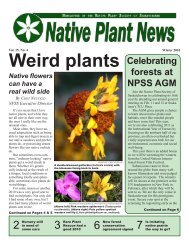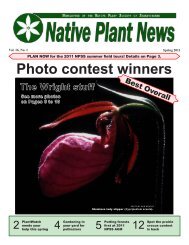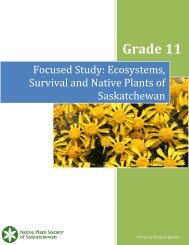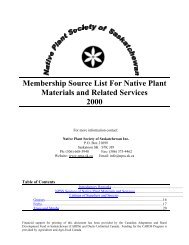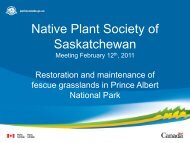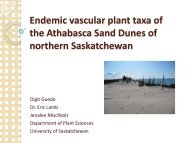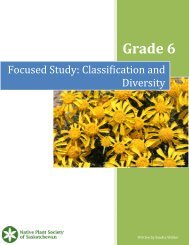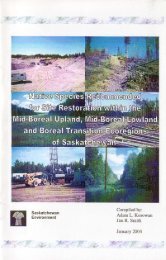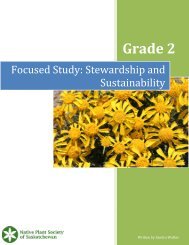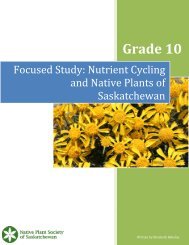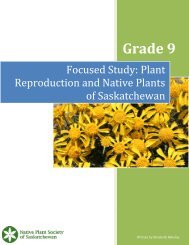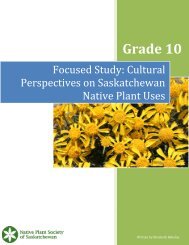Cypress Hills - Orchids Checklist - AlbertaParks.ca
Cypress Hills - Orchids Checklist - AlbertaParks.ca
Cypress Hills - Orchids Checklist - AlbertaParks.ca
You also want an ePaper? Increase the reach of your titles
YUMPU automatically turns print PDFs into web optimized ePapers that Google loves.
Ice Age Remnant At the end of the last Ice Age, forests<br />
stretched across the plains from the <strong>Cypress</strong> <strong>Hills</strong> to the<br />
Rocky Mountains. As the climate warmed, grasses took<br />
over, leaving an isolated remnant of this ancient forest in<br />
the higher elevations of the <strong>Cypress</strong> <strong>Hills</strong>. With a<br />
wetter, cooler climate than the surrounding prairies, the<br />
hills are now a refuge for many forest plants for from<br />
their normal ranges.<br />
A Refuge for <strong>Orchids</strong> <strong>Orchids</strong> are among the rarest<br />
and most interesting plants that have found refuge in the<br />
<strong>Cypress</strong> <strong>Hills</strong>. At least 18 species and 2 varieties of<br />
orchids have been reported from the <strong>Cypress</strong> <strong>Hills</strong> of<br />
Alberta and Saskatchewan. Some are uncommon in the<br />
rest of Canada, but are quite abundant here. Other rare<br />
species have only recently been reported. Careful<br />
searching may reveal even more unreported species and<br />
varieties. Provincial parks in Alberta and Saskatchewan,<br />
jointly administered as an Interprovincial Park, now<br />
protect much of the <strong>Cypress</strong> <strong>Hills</strong> habitat of these<br />
unusual flowers.<br />
Orchid Description Found throughout the world, most<br />
orchids are tropi<strong>ca</strong>l species and grow on trees. In North<br />
Ameri<strong>ca</strong>, orchids are generally quite small and grow on<br />
the ground, and some obtain nutrients from de<strong>ca</strong>ying<br />
soil matter. To germinate and grow, orchid seeds need<br />
to be invaded by a fungus. The most distinctive aspect<br />
of orchids are their flowers, consisting of three separate<br />
sepals, often resembling petals, and two separate lateral<br />
petals. A third, lower petal usually forms an elaborate<br />
and unusually shaped lip, often bearing a backward<br />
projecting spur. In the centre of the flower a complex<br />
structure <strong>ca</strong>lled the column holds the reproductive<br />
organs.<br />
Orchid <strong>Checklist</strong> This checklist contains information<br />
on all the orchids found in the <strong>Cypress</strong> <strong>Hills</strong> of both<br />
Alberta and Saskatchewan. Use this key to understand<br />
the abbreviations:<br />
D – description of the flower<br />
H – typi<strong>ca</strong>l habitat in the <strong>Cypress</strong> <strong>Hills</strong><br />
F – usual flowering season<br />
A – relative abundance in the <strong>Cypress</strong> <strong>Hills</strong><br />
R – remarks or comments<br />
Calypso Orchid<br />
Calypso bulbosa<br />
D sepals and petals pink, purple and some yellow; large<br />
sac-like lip pinkinsh with purple streaks and yellow<br />
hairs; a single flower 1.3-2.5 cm long. H drier soil in<br />
pine woods F mid-May/ early June A common and<br />
abundant in Alberta hills; very rare in Saskatchewan<br />
hills R most common and striking orchid on the Alberta<br />
side of the <strong>Cypress</strong> <strong>Hills</strong>; decreasing in abundance<br />
throughout North Ameri<strong>ca</strong> due to logging and picking.<br />
Spotted Coral-root Orchid<br />
Corrallorhiza maculata<br />
D petals and 3-lobed lip white with purple spots, 0.6 cm<br />
long; sepals pale greenish-yellow with purple trim;<br />
conspicuous yellow spur; 10-40 flowers H drier soils in<br />
aspen woodlands and open pine woods F late June/<br />
early August A fairly common and abundant R all<br />
coral-root orchids lack green colour in stalks.<br />
Stripped Coral-root Orchid<br />
Corallorhiza striata<br />
D sepals and petals white with three purple stripes; lip<br />
white to maroon with five dark purple stripes, 1.3 cm<br />
long; no spur; 15-25 flowers H dry to damp soil in<br />
woods F mid – May / early August A fairly common<br />
and abundant R a rare orchid in North Ameri<strong>ca</strong>; an<br />
extremely rare non-stripped variety of this orchid is<br />
found only in the <strong>Cypress</strong> <strong>Hills</strong>.<br />
Pale Coral-root Orchid<br />
Corallorhiza trifida<br />
D sepals and petals greenish-yellow; 3-lobed lip<br />
whitish spotted with purple, 0.5 cm long; no spur; 3-12<br />
flowers H moist, wooded areas F mid – May / early<br />
August A fairly common but not abundant.<br />
Yellow Lady’s Slipper<br />
Cypripedium <strong>ca</strong>lceolus<br />
D sepals yellowish or greenish, striped with purple, 3-<br />
5 cm long; petals greenish-yellow to purplish-brown,<br />
twisted, 3-5 cm long; pouch-shaped lip yellow marked<br />
with purple, 1.5-4 cm long; 1 flower H moist, open<br />
areas in woods and along banks and ditches F June A<br />
very rare in Saskatchewan hills; not reported from<br />
Alberta.<br />
Mountain Lady’s Slipper<br />
Cypripedium montanum<br />
D sepals and petals greenish-brown to purple-brown,<br />
twisted, 4-6 cm long; luminescent white lip striped<br />
with purple, 2-3 cm long; 1-3 flowers H moist woods<br />
F late May / July A known from one lo<strong>ca</strong>tion in<br />
Saskatchewan <strong>Cypress</strong> <strong>Hills</strong> R first reported from hills<br />
in 1984; a rare species.<br />
Sparrow’s Egg lady Slipper<br />
Cypripedium passerinum<br />
D sepals green, petals pure white; pouch-shaped,<br />
translucent lip white or pale lilac, spotted with<br />
purple, 1 cm long; no spur H margins of ponds,<br />
streams and bogs in mossy spruce forests F mid-<br />
June / early August A rare but lo<strong>ca</strong>lly abundant<br />
Rattlesnake-Plantain<br />
Goodyera oblongifolia<br />
D sepals and petals greenish-white, forming hood;<br />
spout-like lip greenish-white, 6-9 mm long; no spur;<br />
numerous flowers in a single, long spiral spike H<br />
drier, cool soil in coniferous woods F late July / mid-<br />
August A uncommon but lo<strong>ca</strong>lly abundant R a<br />
second species, Goodyera repens, has also been<br />
reported<br />
Tall White Bog Orchid<br />
Habenaria dilata<br />
D sepals and petals white to yellowish-white or<br />
greenish-white; lance-shaped lip waxy white, 5-10<br />
mm long; sharp, slender spur; numerous small<br />
flowers H rich soils in wet coniferous woods, bogs,<br />
thickets and meadows F early June / early August A<br />
rare in Saskatchewan hills; not reported in Alberta<br />
portion R strong fragrance of cloves or vanilla
Northern Green Bog Orchid<br />
Habenaria hyperborea<br />
D sepals and petals yellow-green; tongue-shaped lip pale<br />
green, 0.6 cm long; club-shaped spur; numerous flowers<br />
in a long, dense spike H along creeks and ponds, springy<br />
areas in moist coniferous woods F late May/ early<br />
August A fairly common and abundant on the Alberta<br />
side; rare in Sask. <strong>Hills</strong><br />
Blunt-leaved Bog Orchid<br />
Habenaria obtusata<br />
D sepals and petals green; narrow, tapering lip pale<br />
greenish-white with downward bend, 1 cm long; slender,<br />
tapering spur; a few flowers in short, loose spike H<br />
boggy areas in spruce woods F mid-June / early August<br />
A uncommon in Sask. R difficult to find; pollinated by<br />
mosquitoes.<br />
Bracted Bog Orchid<br />
Habenaria viridis<br />
D sepals green; thread-like petals greenish – white; 2-3<br />
lobed lip greenish-white sometimes streaked with<br />
purple, 1 cm long; sac-like spur; numerous flowers in a<br />
long, loose spike H damp soil in meadows in pine and<br />
aspen woods F mid-June / mid-August A uncommon but<br />
lo<strong>ca</strong>lly abundant<br />
Northern Twayblade<br />
Listera borealis<br />
D awl-shaped sepals and petals green; 2-lobed lip<br />
translucent pale green with central dark green stripe, 1.3<br />
cm long; no spur; several flowers in loose spike H wet,<br />
cold, moss-covered soil in mature spruce woods F late<br />
May/ early August A rare; confined to remote, boggy<br />
valleys<br />
Heart-leaved Twayblade<br />
Listera cordata<br />
D sepals and petals purplish to yellowish green; 2 lobed<br />
lip purplish green, 4-5 mm long; no spur; 4-20 tiny<br />
flowers H acidic soils in mossy woods, thickets and<br />
bogs F early June/ early August A rare in Saskatchewan<br />
hills; not recorded from Alberta side.<br />
White Adder’s Mouth<br />
Orchis monophylla<br />
D sepals and petals greenish to yellowish; drooping,<br />
oval – shaped lip tapering to a point, greenish to<br />
yellowish, 2 – 3 mm long; no spur H damp woods,<br />
banks and bogs F June A rare R first reported in the<br />
Alberta <strong>Cypress</strong> <strong>Hills</strong> in 1988; considered a rare species<br />
elsewhere in Alberta.<br />
Round-leaved Orchid<br />
Orchis rotundifolia<br />
D sepals and petals pale pink; 3 – lobed lip white,<br />
spotted with purple, 0.8 cm long; stout, curved spur; 3 -<br />
6 flowers H moss covered, springy wet soil along<br />
streams in mature spruce forests F late May / early July<br />
A uncommon but fairly abundant in remote undisturbed<br />
valleys R a very rare variety with a purple striped lip is<br />
known only from the <strong>Cypress</strong> hills and a few spots in<br />
Ontario.<br />
Hooded Ladies’ Tresses<br />
Spiranthes romanzoffiana<br />
D sepals and petals creamy – white, forming a hood;<br />
fiddle – shaped lip creamy – white and bent<br />
downward, 0.6 cm long; no spur; numerous flowers in<br />
a short twisted spike H bogs, open woods, meadows,<br />
moist depressions in fescue grasslands F late July /<br />
August A fairly common and lo<strong>ca</strong>lly abundant on<br />
Alberta side; rare in Sask. <strong>Hills</strong> R last orchid to bloom<br />
each summer<br />
Searching For <strong>Orchids</strong><br />
The best time of year to look for orchids is mid –<br />
June, when most of the species are in bloom<br />
throughout most of the summer. Searching for<br />
orchids is a wonderful way to explore the <strong>Cypress</strong><br />
<strong>Hills</strong>, but please take <strong>ca</strong>re not to disturb these<br />
fragile and unique plants or their habitats. <strong>Orchids</strong><br />
rarely survive transplanting, and picking the<br />
flowers will prevent orchids from reproducing. If<br />
you find an orchid, the best way to preserve it is<br />
with a photograph. Without <strong>ca</strong>re and respect,<br />
orchids may disappear from their refuge in the<br />
hills.<br />
For More Information<br />
Please help us protect the orchids of <strong>Cypress</strong> <strong>Hills</strong>.<br />
If you discover a rare orchid, please notify park<br />
staff. If you have any comments or questions,<br />
drop by one of the Visitor Centres, or write to:<br />
<strong>Cypress</strong> <strong>Hills</strong> Interprovincial Park<br />
Box 12 Box 850<br />
Elkwater, Alberta Maple Creek, Sk.<br />
T0J 1C0<br />
S0N 1N0<br />
(403) 893-3777 (306) 662-4411<br />
Text: Michael Klassen<br />
Illustrations: Keli Pollock<br />
ORCHIDS<br />
<strong>Cypress</strong> <strong>Hills</strong> Interprovincial Park<br />
The diversity and abundance of orchids<br />
found in the <strong>Cypress</strong> <strong>Hills</strong> <strong>ca</strong>nnot be<br />
matched anywhere else on the prairies.<br />
Many of these fragile and beautiful<br />
flowers <strong>ca</strong>n be found while hiking in<br />
early summer, making this area an<br />
orchid-lover’s haven. Use this fact<br />
sheet to help you discover and identify<br />
the orchids of the <strong>Cypress</strong> <strong>Hills</strong><br />
Fact Sheet



